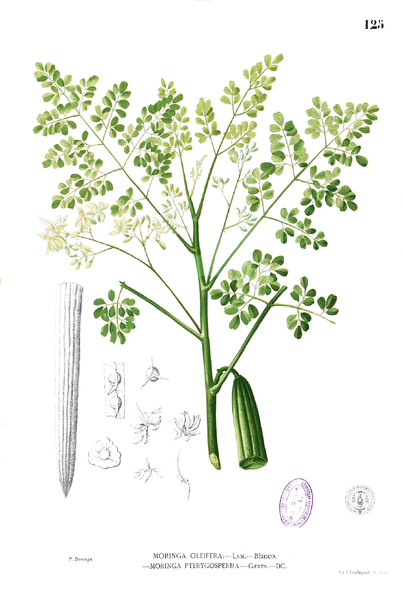Moringa oleifera, is known variously as the horseradish tree, ben oil tree, or drumstick tree.

Cultivation
The moringa tree is grown mainly in semiarid, tropical, and subtropical areas, corresponding in the United States to USDA hardiness zones 9 and 10. While it grows best in dry, sandy soil, it tolerates poor soil, including coastal areas. It is a fast-growing, drought-resistant tree that is native to the southern foothills of the Himalayas in northwestern India. Moringa is propagated by planting 1ââ¬â2 m-long limbs cuttings, preferably from June to August. The plant starts bearing pods 6ââ¬â8 months after planting, but regular bearing commences after the second year, continuing for several years. It can also be propagated by seeds, which are planted an inch below the surface and can be germinated year-round in well-draining soil.As with all plants, optimum cultivation depends on producing the right environment for the plant to thrive. Moringa is a sun and heat-loving plant, and does not well tolerate freeze or frost. Moringa is particularly suitable for dry regions, as it can be grown using rainwater without expensive irrigation techniques. It has also been grown in aquaponics.
Uses
The bark, sap, roots, leaves, seeds, oil, and flowers are used in traditional medicine in several countries.The sap can be used as a blue dye.
Many parts of the moringa are edible:
- The immature seed pods, called "drumsticks"
- Leaves
- Mature seeds
- Oil pressed from the mature seeds
- Roots
Flowers
The flowers are edible when cooked and are said to taste like mushrooms.Drumsticks
The immature seed pods, called "drumsticks", can be prepared by parboiling, and cooked in a sauce until soft.The seed pods are particularly high in vitamin C.Leaves
The leaves are the most nutritious part of the plant, being a significant source of vitamin B6, vitamin C, provitamin A as beta-carotene, magnesium and protein, among other nutrients reported by the USDA, shown in the table, right column. When compared with common foods particularly high in certain nutrients, fresh moringa leaves are considerable sources of these same nutrients. Per gram, moringa leaves contain 4 times as much Vitamin A as a carrot, and nearly 4 times the calcium of milk, 3 times the potassium of banana, twice the protein of yogurt, and 7 times the vitamin C of an orange.Some of the calcium in moringa leaves is bound as crystals of calcium oxalate which may inhibit calcium availability to the body. It is not clear whether the calculation of the reported amount of calcium in moringa leaves includes such non-bioavailable calcium.
The leaves are cooked and used like spinach. In addition to being used fresh as a substitute for spinach, its leaves are commonly dried and crushed into a powder used in soups and sauces. It is important to remember that like most plants heating moringa above 140 degrees Fahrenheit will destroy some of the nutritional value.
Seeds
The seeds, sometimes removed from more mature pods and eaten like peas or roasted like nuts, contain high levels of vitamin C and moderate amounts of B vitamins and dietary minerals.Seed oil
Seeds contain ben oil, which has been used for thousands of years as a perfume base. The oil can also be used as a fuel or as a machine lubricant. Mature seeds yield 38ââ¬â40% ben oil from its high concentration of behenic acid. The refined edible oil is clear and odorless, and resists rancidity. The seed cake remaining after oil extraction may be used as a fertilizer or as a flocculent to purify water.Roots
The roots may be shredded and used as a condiment in the same way as horseradish. However, they contain an alkaloid, potentially having nerve-paralyzing properties, which may be used medicinally.more